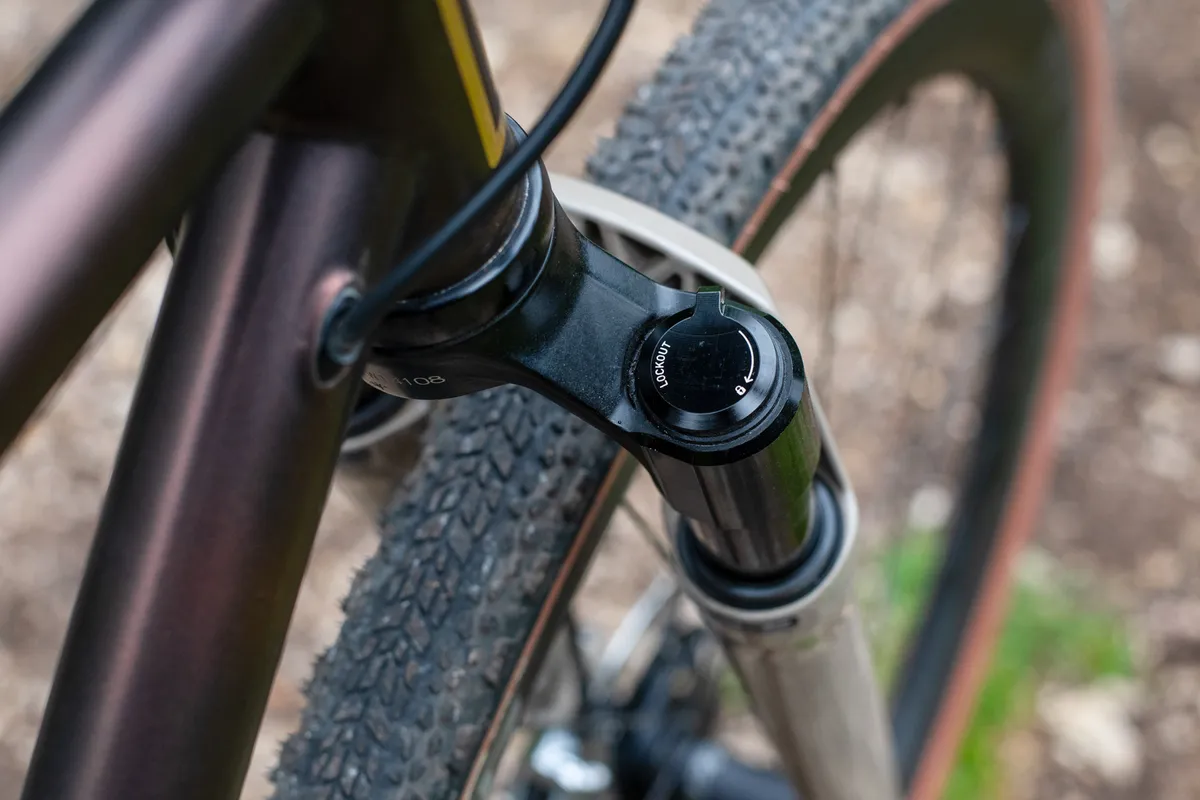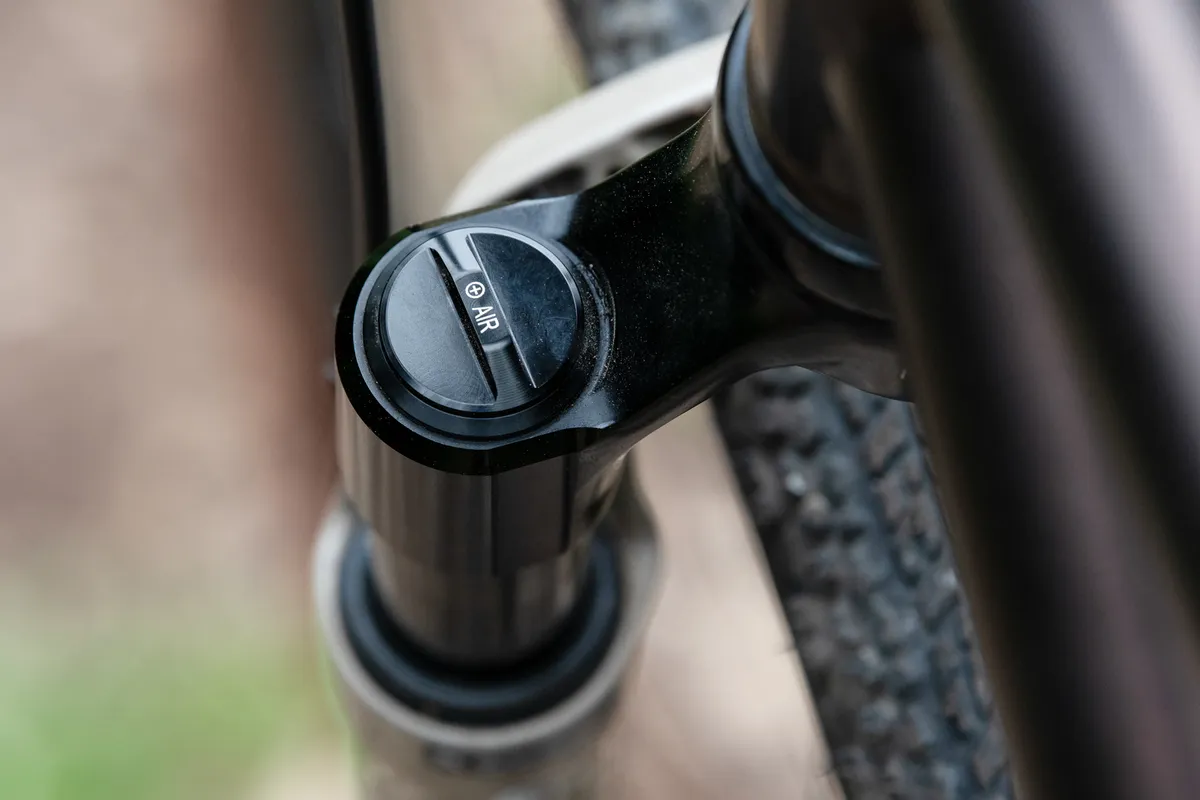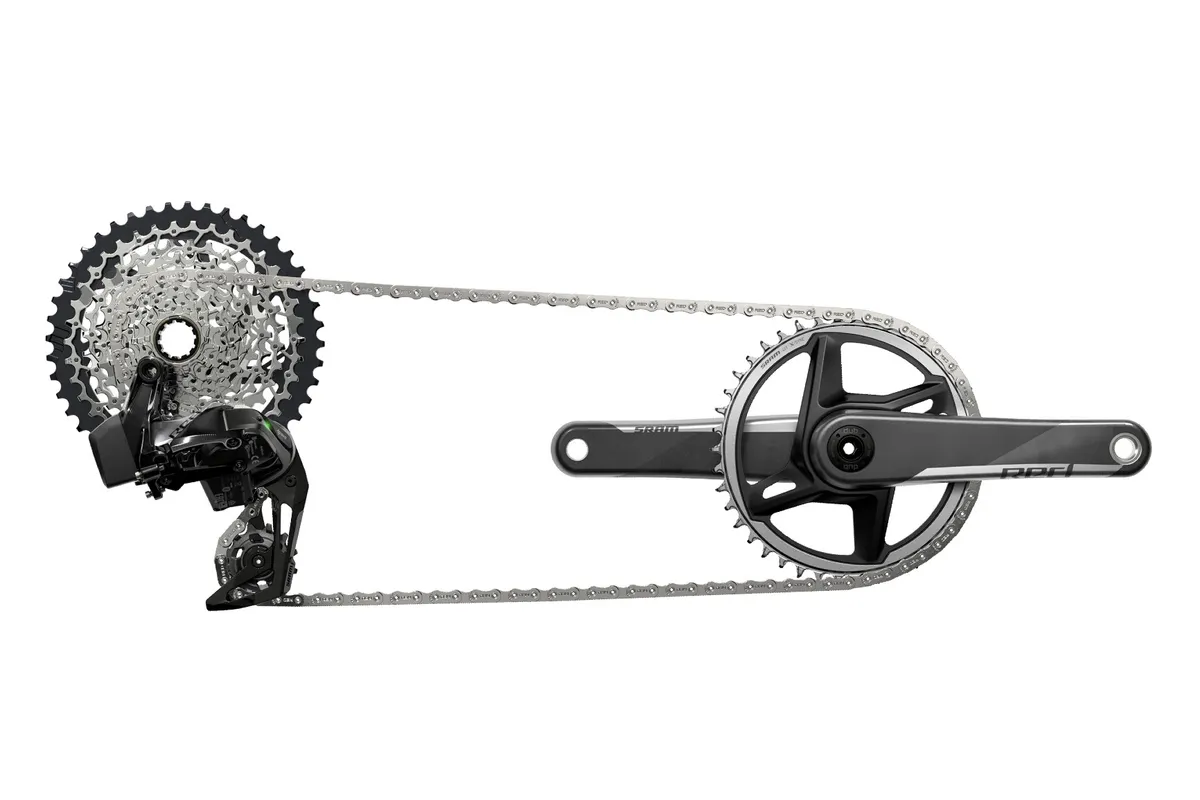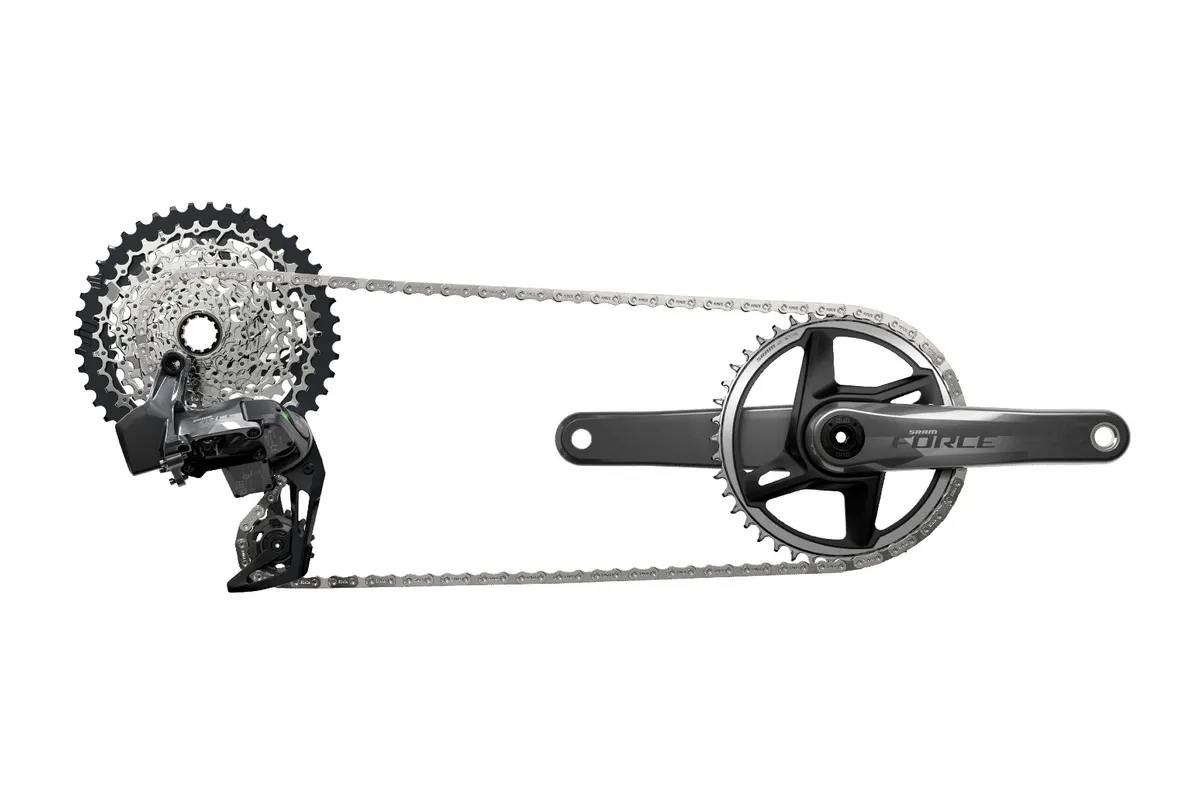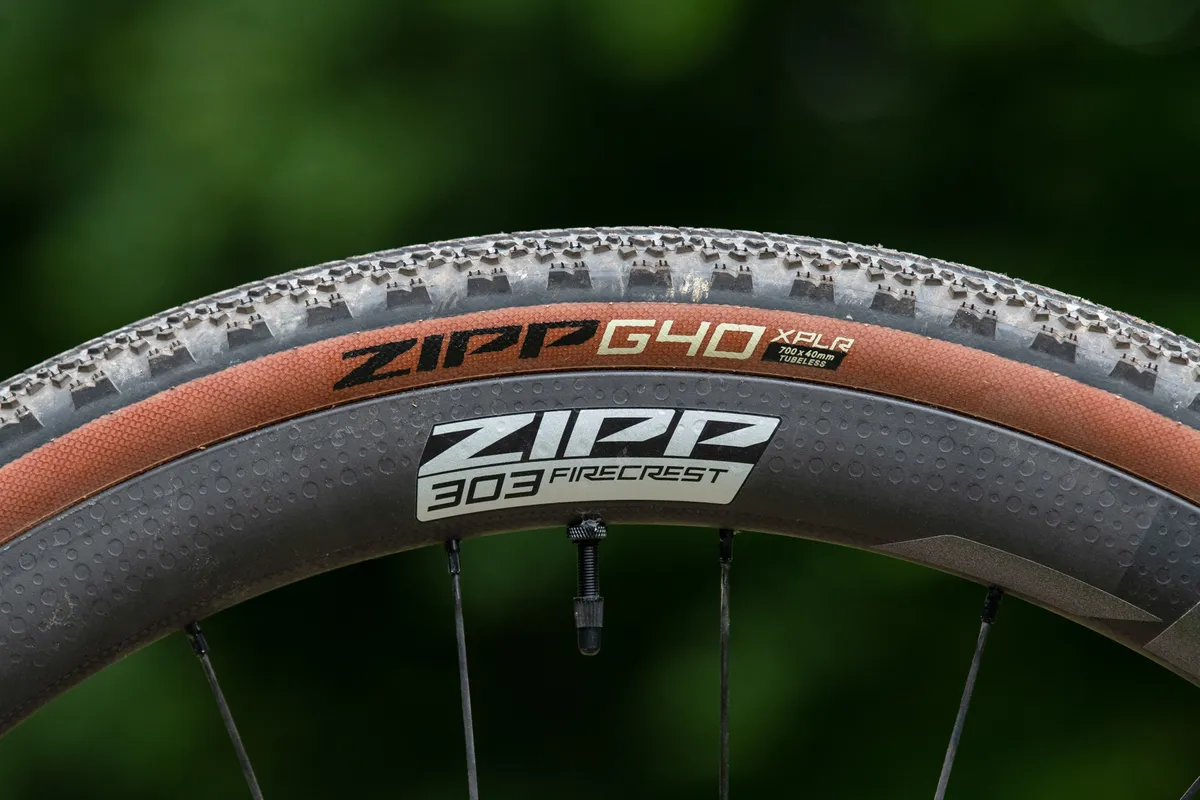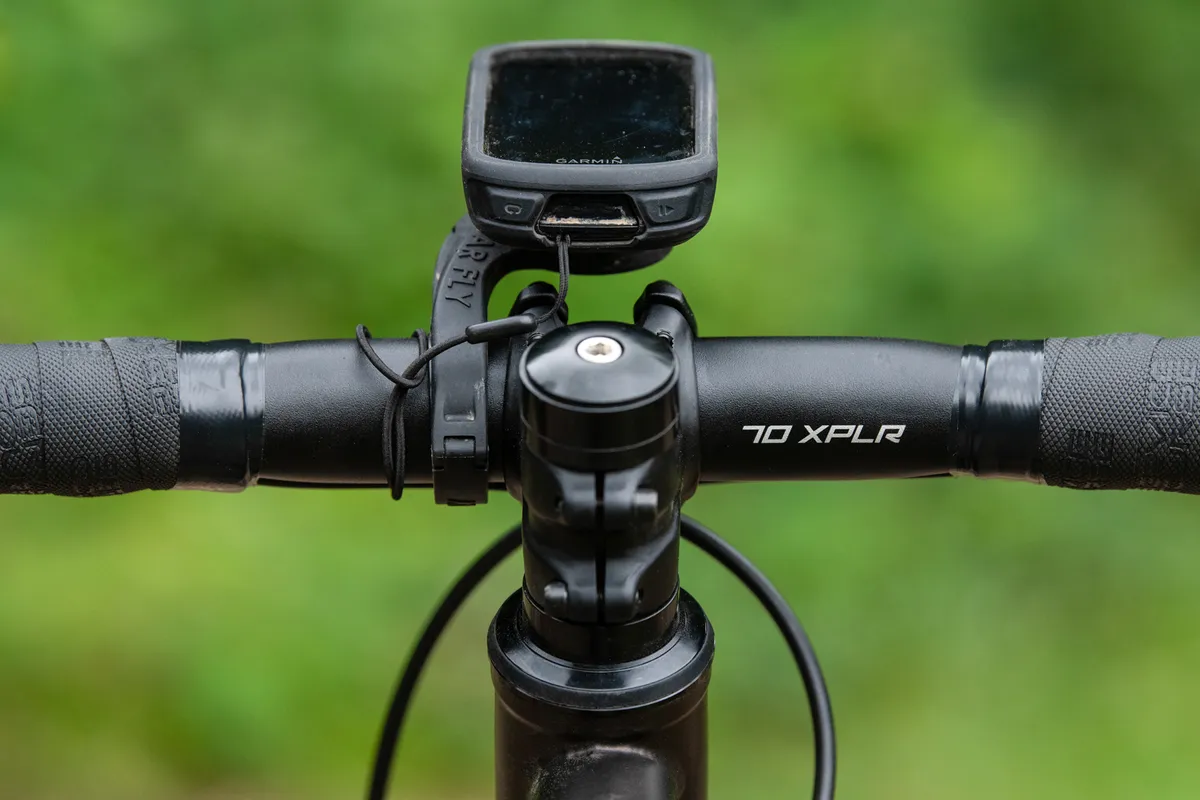SRAM, RockShox, and Zipp have joined forces to launch a gravel collaboration called XPLR.
The range includes a line-up of gravel-specific gearing options from SRAM, a gravel suspension fork and dropper post from RockShox and gravel wheels, tyres and finishing kit from Zipp.
The XPLR range is designed to bring a wider choice than ever to the gravel world, with SRAM, RockShox and Zipp (all three brands are owned by the same company) aiming to give riders the opportunity to fine-tune their gravel bike setup – “Designed to give road riders, mountain bikers and gravel grinders unlimited new ways to get after it” is how it’s described in the press material.
5 key XPLR details
Before we get stuck into the details – and there’s a lot to cover across the three brands – here are five key things you need to know about XPLR (pronounced ‘explore’, if you were wondering).
- SRAM’s wireless AXS drivetrains now get XPLR options across all three tiers, from Rival, through Force and up to flagship Red
- XPLR gearing means a new, lighter 1x direct-mount chainset, a new 10-44t cassette option and a new rear eTap AXS derailleur designed to accommodate the wider range
- The RockShox Rudy Ultimate XPLR fork has been designed from the ground-up for gravel riding and comes in 30mm and 40mm travel options, with 700c x 50mm tyre clearance
- The wireless RockShox Reverb AXS dropper doubles as both a dropper post (50mm and 75mm travel options) and suspension seatpost
- Zipp’s 101 XPLR wheelset brings vibration damping from the single-wall construction previously found on the brand’s Moto mountain bike wheels
Right, let’s dive in, starting with suspension. Otherwise, if you want to read our initial verdict, BikeRadar’s technical editor-in-chief, Rob Weaver, has delivered his first impressions on the XPLR drivetrain, fork and dropper post.
RockShox brings suspension to the gravel party
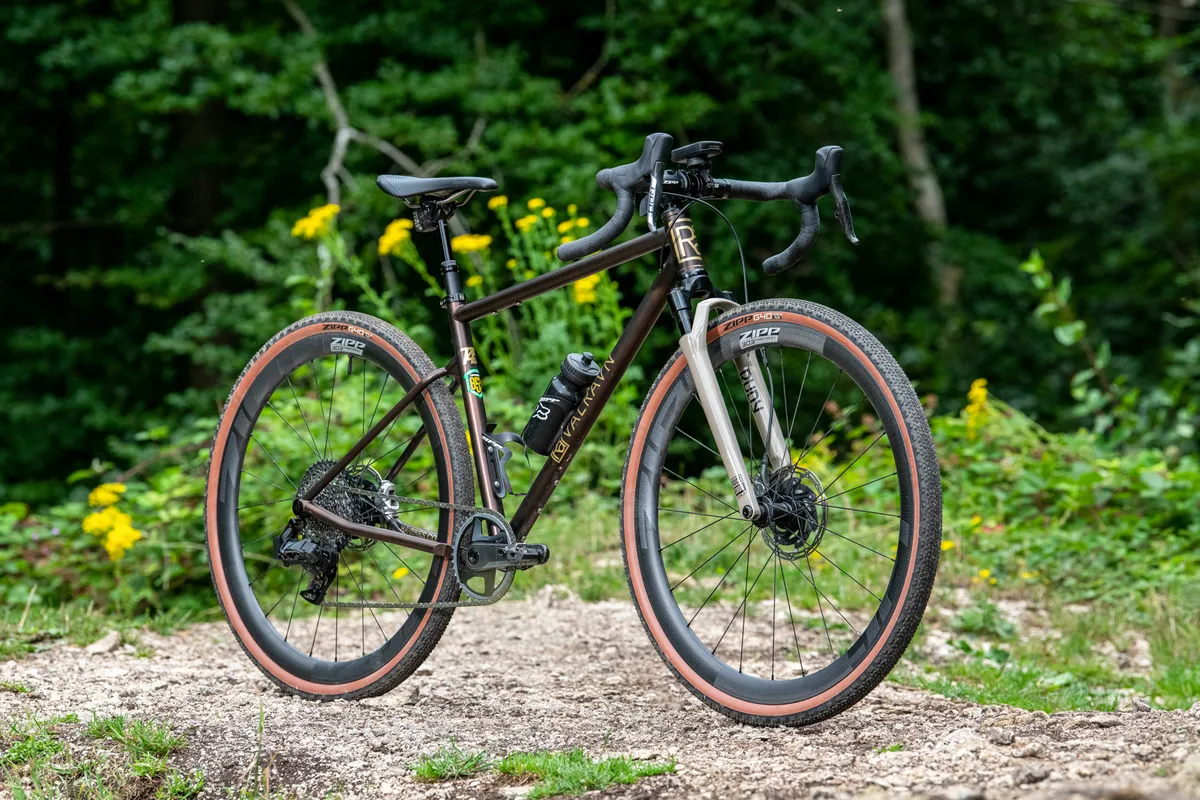
We’ll come on to SRAM’s XPLR gearing but the biggest news – and perhaps the most controversial – is RockShox’ step into the world of gravel bike suspension. (Update 04/04/22: You can now read our full RockShox Rudy Ultimate XPLR review)
Or perhaps we should say that RockShox is stepping back into the world of drop-bar suspension. Yes, of course, SRAM was a front-runner here more than 25 years ago. The original RockShox Paris Roubaix SL fork was used by French rider Gilbert Duclos-Lassalle when he won the Hell of the North in 1992 , before the fork became the road-going Ruby.
Drop-bar suspension forks quickly disappeared in the years that followed, only to be reintroduced for the burgeoning gravel world, with the likes of Fox, MRP, Cannondale (with the Lefty Oliver), SR Suntour and Lauf offering gravel suspension.
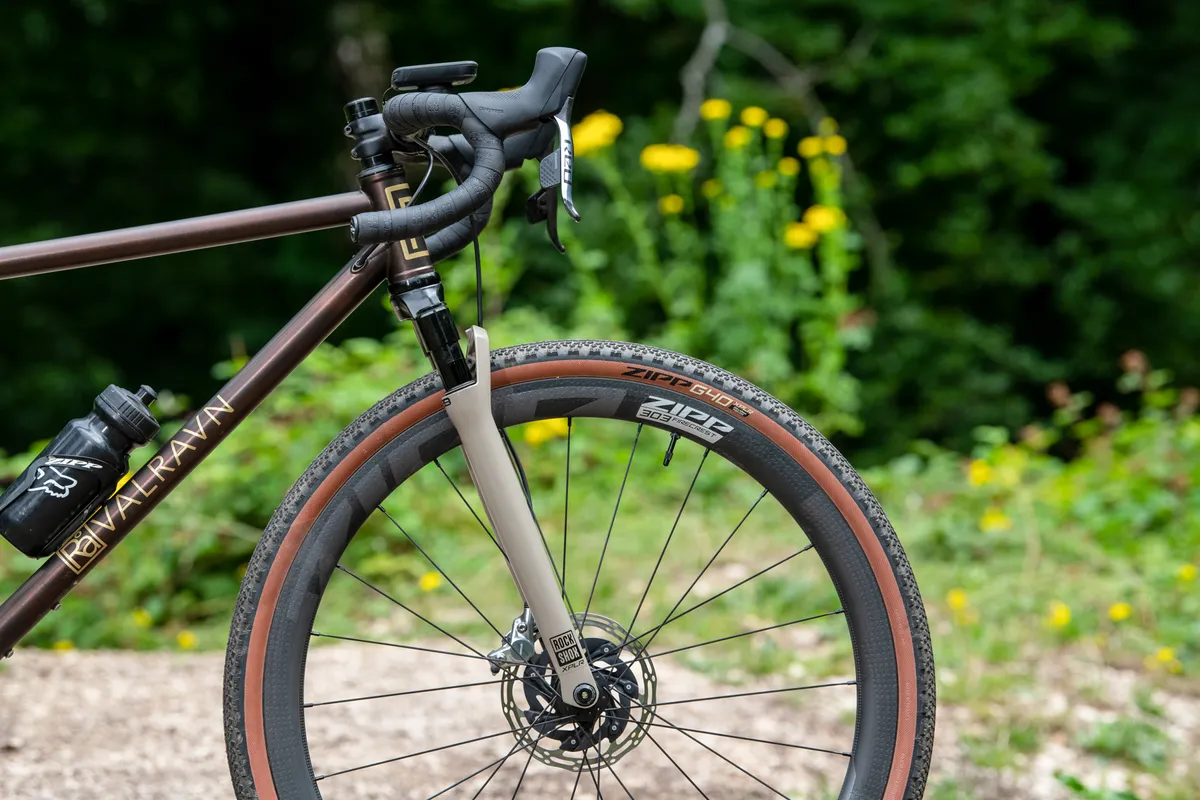
The new RockShox fork is called the Rudy Ultimate XPLR and is designed around 700c wheels. When BikeRadar quizzed RockShox on the reason for sticking with 700c, it told us the reason gravel riders usually opt for 650b wheels is to take advantage of the extra tyre volume the smaller wheel size allows for, and thus extra comfort, but a suspension fork takes care of that.
You also get the increased rolling speed afforded by a larger diameter wheel – plus the Rudy offers a massive 50mm of clearance for 700c tyres.
It will, of course, be possible to still unofficially run a 650b wheel in the fork, but this could affect front-end geometry and handling.
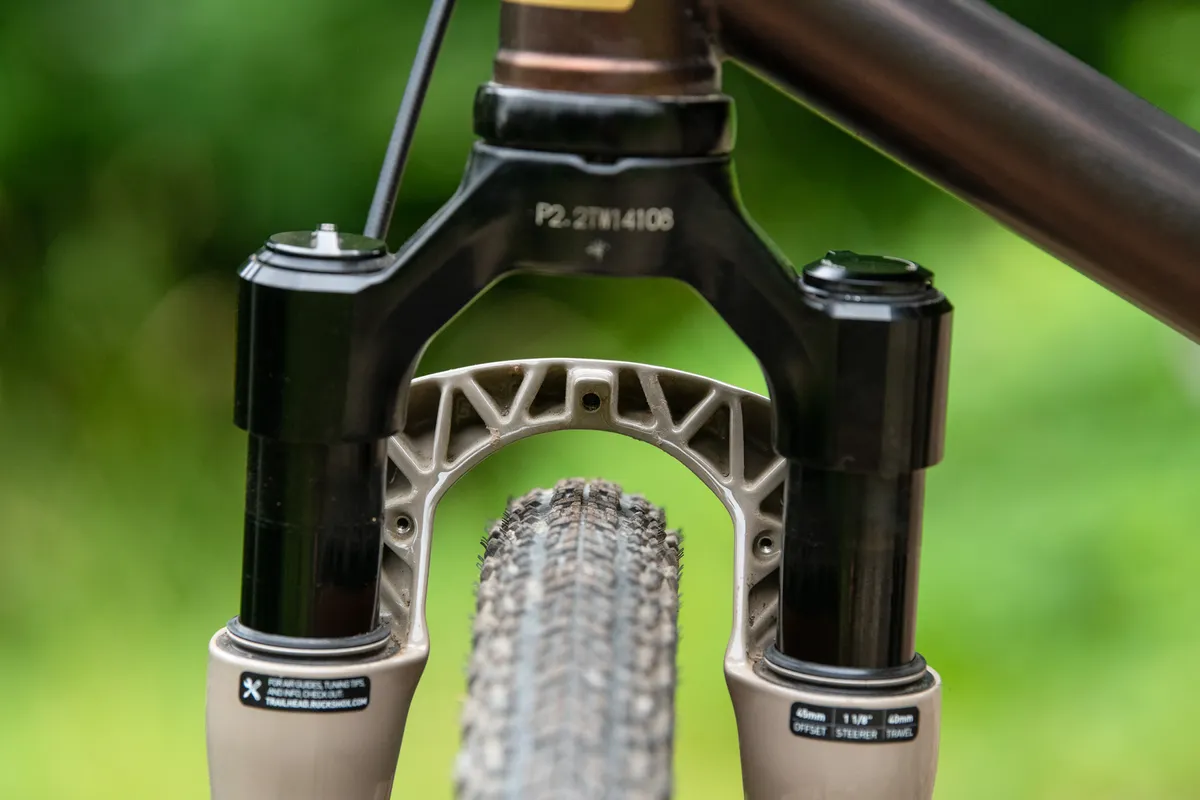
RockShox says this is a completely new fork – not a slimmed-down SID mountain bike fork or an old model reinstated.
The design features 30mm upper tubes to make for a lightweight unit, fixed to an all-alloy machined and anodised crown. For comparison, most modern mountain bike forks use stanchions that are 34mm, 36mm or 38mm in diameter (the SID is 35mm) depending on their intended use.
The fork is compatible with three-bolt, short arch-mounted fenders, but it will also take a full fender (mudguard) because the fork lowers have eyelets too.
Internally, the Rudy uses a new version of the Charger Race Day damper usually found in the SID. It’s RockShox’ lightest-ever damper unit and is matched to a Solo air spring that's tuned for short travel to complement the Rudy’s 30mm and 40mm options. It all runs on Maxima Plush damping fluid.
The Solo air spring, by the way, is a RockShox design that uses a single Schrader air valve to charge both positive and negative spring chambers simultaneously, making for a fast setup. It’s also the lightest air spring on the market.
Suspension fork setup will be a mysterious new world to a lot of gravel riders coming from the road. Like all RockShox forks, the Rudy comes with the usual air pressure settings (by rider weight) on the lowers and the Rudy specifications will be added to the clever Trail Head app, too.
The system has been designed with a ‘bottomless’ feel, according to RockShox, ramping up resistance before you get a tell-tale clunk. The maximum of 40mm of travel may seem minimal to mountain bikers, but RockShox claims it won’t suffer from any clumsy bottoming out, even on high-speed hits. The fork comes with a lockout for tarmac sections.
As standard, it has a 45mm offset and is designed around bikes with a 405mm to 410mm axle-to-crown length, so it’s worth checking your gravel bike’s geometry before taking the upgrade plunge.
The Rudy’s claimed weight is 1.3kg but that’s dependent on steerer tube length/options. By comparison, the SID Ultimate tips the scales at 1.61kg.
The RockShox suspension fork will be available in ‘kwiqsand’ (that’s sand to you and me) and gloss black colourways, and it’s also electric bike-approved, for assisted gravel fans.
Expect to see the Rudy specced on plenty of 2022 gravel bikes, including a special OE (original equipment) version that comes without a lockout. This OE fork is available in both 45mm and 51mm offsets.
A Charger Race Day damper kit upgrade will also be available for £250/$250/€280, allowing you to add the lockout down the line should you wish.
RockShox Rudy Ultimate XPLR pricing
The fork is set to be priced at £779 / $799 / €869. The price includes star nut, fender (also sold separately, £20 / $20 / €23), and Maxle stealth axle (also sold separately, £39 / $42 / €43).
Dropping in with the Reverb AXS XPLR
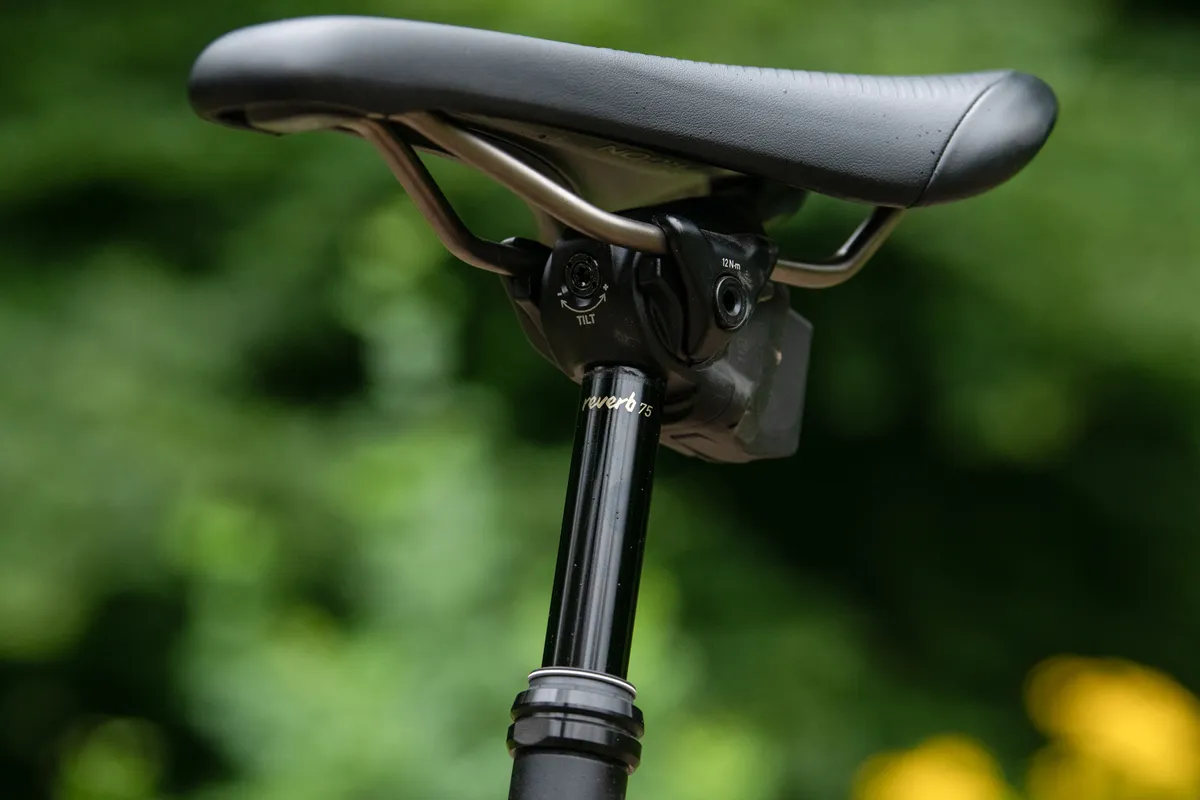
RockShox’ second contribution to the XPLR range is an all-new Reverb AXS XPLR dropper post with 50mm and 75mm of travel.
For those of you who haven’t come across droppers before, a dropper post is a seatpost that allows for quick adjustment of saddle height without having to stop and get off your bike, allowing you to move the saddle out of the way on technical terrain.
Up until now, there have been a few road/gravel droppers available, including the FSA Flowtron AGX and Crankbrothers Highline XC/Gravel. Both are cable-actuated, so your bike needs dropper-compatible routing and a remote control mounted on your bar.
The Reverb AXS XPLR, however, works wirelessly and is powered by a standard eTap battery mounted on the rear of the seatpost. Actuation is via the bike's AXS shifters; in 1x configuration (as SRAM’s XPLR drivetrain is set up) you press both buttons at the same time to operate the post.
It’ll work the same way with a 2x system if you set up sequential shifting through the AXS app, which takes care of front ring shifts automatically, therefore freeing up the double-button function for the dropper.
The Reverb is compatible with all AXS levels from third-tier Rival, through Force and up to top-of-the-range SRAM Red eTap shifters.
The Reverb AXS XPLR is based on the clever wireless Reverb AXS mountain bike dropper post, but in a gravel bike-friendly 27.2mm diameter.
Unlike its mountain bike inspiration, however, the XPLR model is stripped down and lighter: the 400mm option with 75mm of travel is 597g with battery, while the 350mm post with 50mm of travel is 567g with battery (the mountain bike Reverb AXS is 650g). It’s a suspension post, too, which we'll come on to.

There are also key differences between the gravel and MTB droppers beyond weight.
First, the internals are air only (Reverb AXS for mountain bikes is an air/oil shock, which makes the unit heavier and more complex), with RockShox saying it’s been designed this way as the XPLR Reverb is more than just a dropper.
When the post is fully extended (set at your correct saddle height), it’s rock-solid and fully locked out, but by dropping the post even a few millimetres you’ll add some suspension into the mix.
The post’s ‘Activeride’ feature allows what are effectively air shock internals to work like rear suspension. Of course, it’ll also drop all the way down and out of the way for technical terrain (or if you want to get into a super-tuck on a descent).
Through the AXS app you’ll also be able to customise the post’s setup, so that means if you’re running Force AXS or Red AXS with additional ‘blip’ remote buttons, you can assign these to operate the Reverb.
The post will be available in 350mm (50mm travel) and 400mm lengths (50mm and 75mm travel options). The newly-designed head is compatible with both 7×10mm oval rails and 7×9mm oval or round seat rails, so it should fit all types of saddle rails, including carbon.
RockShox Reverb AXS XPLR pricing
The Reverb AXS XPLR doesn’t come cheap at £500 / €600 / $600 – a considerable jump from our current favourite cable-operated 27.2mm dropper, the Crankbrothers Highline at £274.
SRAM expands its gravel reach

SRAM has historically had the jump on its rivals when it comes to drop-bar, off-road riding and currently offers a wide range of gearing options for gravel riders, whether you’re tackling fast, dusty gravel races or are fully loaded up for a mountainous bikepacking trip.
The American firm pioneered 1x with the original CX1 drivetrain for cyclocross way back in 2014, which then morphed into Force 1 and expanded out into 1x versions across all mechanical groups.
On the electronic side of things, SRAM’s 12-speed wireless AXS drivetrains have always had a 1x option, including the new, more affordable Rival AXS groupset.
We also saw the arrival of SRAM’s Force ‘Wide’ 2x gearing option in 2020, with a 43/30t super-compact chainset and 10-36t cassette for gravel riding, as well as the Red Max rear derailleur bringing compatibility for a 36-tooth sprocket to the flagship groupset.
When you add in the ability to mix-and-match AXS components from SRAM’s road/gravel and mountain bike line-ups in a ‘mullet’ formation (e.g. using a road crankset with a mountain bike rear mech and SRAM’s huge 10-50t MTB cassette), as found on our current Gravel Bike of the Year, the Cannondale Topstone Lefty, you start to wonder why we need yet more options when it comes to gravel gearing.
Well, SRAM thinks there’s more to be had from a wide-range 1x setup – one that increases the gearing range of the current road/gravel line-up, without extending to MTB levels.
As a result, we’ve got the new XPLR crankset, cassette and rear derailleur options across Rival, Force and Red levels.
Gearing sweetspot
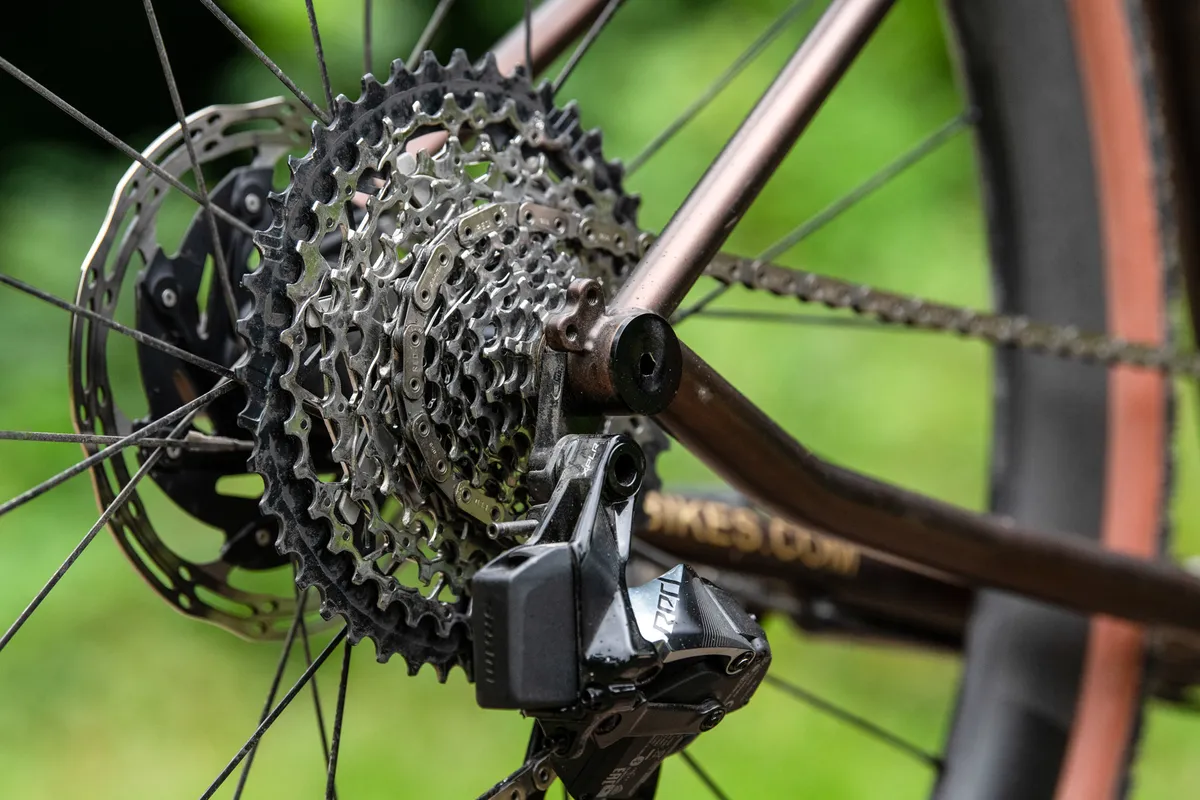
The centrepiece of the XPLR drivetrain is the 10-44t cassette.
SRAM says it has been testing gearing options with the engineering team and sponsored athletes for more than a year to try and nail down the ideal spread across such a broad cassette, and finally settled on a 10, 11, 13, 15, 17, 19, 21, 24, 28, 32, 38, 44 combination.
As you can see, the tooth jumps between gears compress as you run down the block into ‘harder’ gears. SRAM says the feedback they had from riders using a mullet setup was that the jump from 10 to 12 teeth at the bottom of the cassette was noticeable on flatter, fast sections. For comparison, a 10-50t Eagle cassette starts with 10, 12, 14, 16, 18 and 21 teeth, but for XPLR a tighter running order was preferred.
SRAM still thinks the 10-50t cassette is a suitable mullet option for gravel riders looking to ride the toughest of trails, while the existing 10-36t cassette is well-suited for those looking for speed on the road and fast gravel.
The new XPLR option is – no surprises here – designed to fill the gap. SRAM says the 10-44t option is aimed at both rough and road, with smoother gear progression – no big jumps at the top or bottom of the range. It’s a happy medium between the two extremes, according to SRAM.
XPLR cassettes will be available in two options, both using SRAM’s mini-cluster design, whereby the first four sprockets are machined from a single steel billet with the remaining eight pinned together.
The high-grade XG-1271 uses a lighter alloy at the top end and weighs a claimed 373g, while the XG-1251 comes in at a claimed 412g and is all-steel.
XPLR rear derailleur capacity extends to 44 teeth
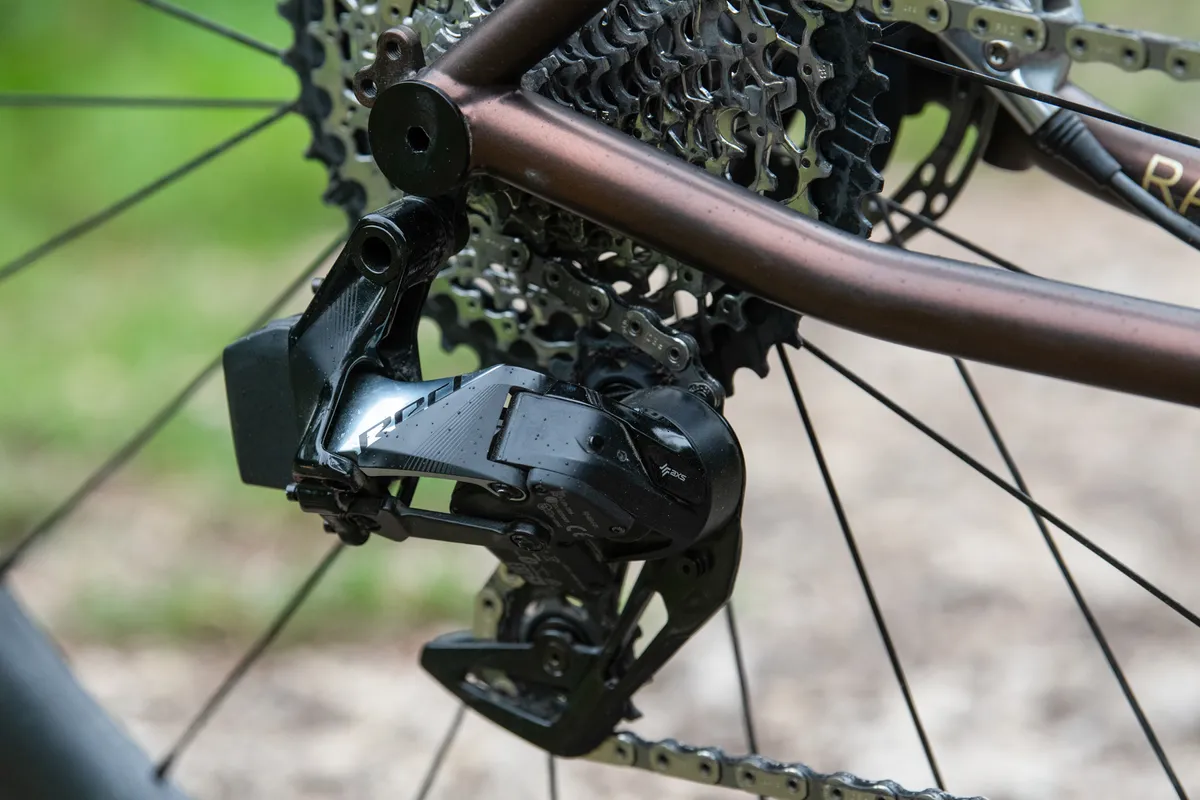
Alongside the cassette, SRAM has also introduced a new XPLR rear mech design. Compared to the standard AXS mechs, which have a maximum capacity of 33 teeth, and the Wide option, with its 36-tooth maximum, the new mech ramps up the range to 44 teeth to match the XPLR cassette.
The XPLR mech is 1x only. Its design differs from the standard AXS systems in that the upper pulley on the mech is offset, meaning it’ll only provide optimal chainline to a single chainring. The pulleys are also oversized compared to the standard AXS mechs.
The XPLR derailleur is designed to work only with the flat-top chains from SRAM’s road AXS groupsets, so mixing it up with mountain bike SRAM Eagle chains isn’t an option.
Like standard AXS, the XPLR rear mechs come with a chain management system. On both Force (£415) and Red (£610) that means the same clever Orbit fluid damper, and on Rival (£236) it’s a spring clutch.
We’ve found the standard SRAM setups to be superb at keeping the drivetrain quiet and the chain in place, so we’ve no reason to doubt the same will be true here.
Finally, as far as the mech is concerned, it uses the standard eTap battery common across all SRAM’s wireless groups, with a claimed 1,000+km of range between charges.
Direct-mountain chainsets for Red and Force XPLR
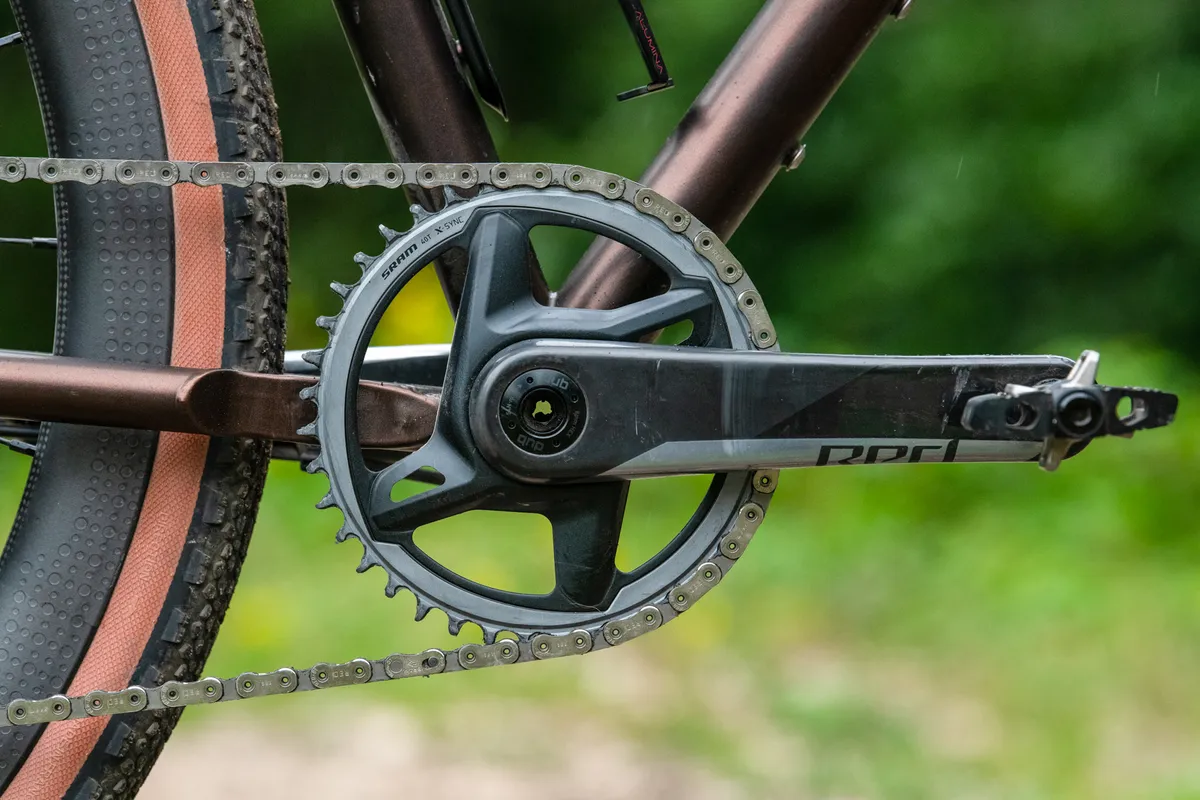
SRAM’s standard Rival, Force and Red chainsets remain unchanged, including the 1x options, but things have been updated for XPLR.
The new XPLR models at Force and Red level use the same cranks arms and spindle as the existing design but, instead of the separate spider and chainring design, moves to a direct-mount chainring (dropping the separate spider/chainring).
This saves between 32g and 35g compared to the non-XPLR models. Rival doesn’t have an XPLR option, instead it uses the existing Rival 1 Wide model.
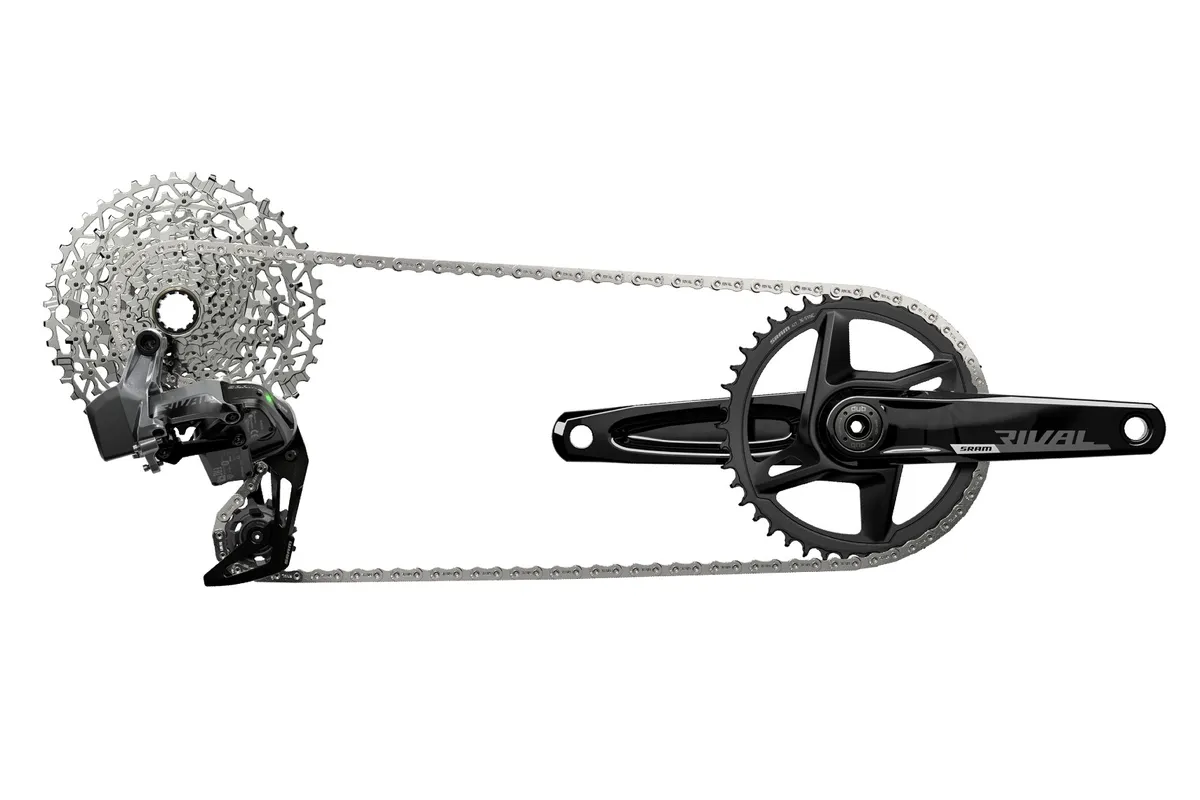
The chainring comes in options from 38 to 46 teeth. If you want to go smaller to a 36-tooth chainring then SRAM tells us you’ll need to use the existing spider.
SRAM will also be offering a ‘wide’ version of XPLR at Force level, with a longer spindle, to meet the needs of a few gravel bikes with wider (Boost) rear spacing (the Focus Atlas is one example) and to make sure the chainline is correct.
Likewise, if you want to run a power meter, you'll need to skip the direct-mount chainring and use a Quarq spider and chainring (as with the existing range) or run the single-sided Rival spindle-based meter.
Example crankset claimed weights are as follows:
- 462g – SRAM Red XPLR, 172.5mm cranks with 40t ring, standard spindle
- 598g – SRAM Force XPLR, 172.5mm cranks with 40t ring, standard spindle
- 604g – SRAM Force Wide, 172.5mm cranks with 40t ring, wide spindle
- 706g – SRAM Rival Wide, 172.5mm cranks with 40t ring, wide spindle
SRAM XPLR pricing
SRAM Red eTap AXS XPLR
- Red XPLR rear derailleur: £610 / $710 / €685
- Cassette (XG-1271): £200 / $210 / €225
- Crankset: £625 / $690 / €700
SRAM Force eTap AXS XPLR
- Force XPLR rear derailleur: £415 / $490 / €465
- Cassette (XG-1251): £145 / $150 / €160
- Crankset: £390 / $420 / €435
SRAM Rival eTap AXS XPLR
- Rival XPLR rear derailleur: £236 / $255 / €265
- Cassette (XG-1251): £145 / $150 / €160
- Crankset (existing Rival 1 Wide): £120 / $130 / €135
Zipp brings Moto to gravel
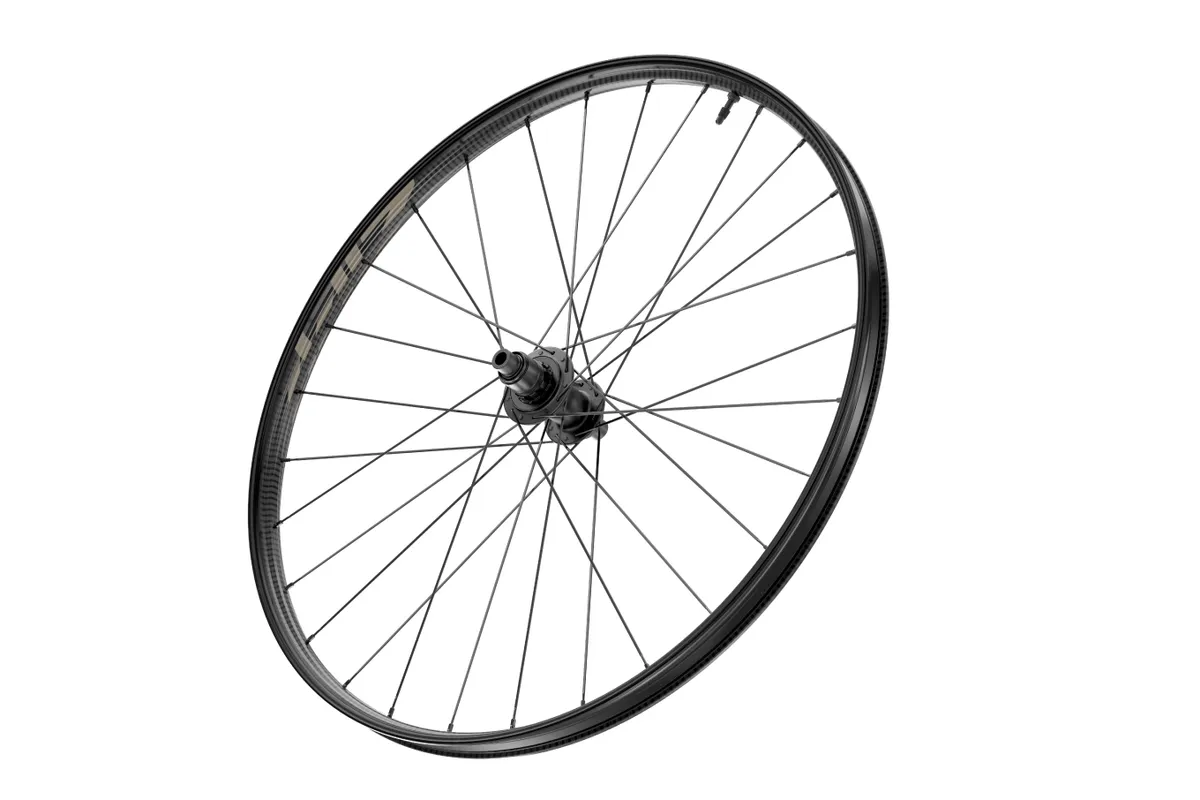
Zipp was the first of the trio to launch XPLR products with the SL70 XPLR handlebar and XPLR gravel tyres, but those were just a taster for the main event – the Zipp 101 XPLR wheelset (101 is a reference’s to Zipp’s old non-aero climbing wheels).
The new 101 couldn’t be further from the narrow, rim brake, alloy wheelset of old. The XPLR 101 is based around the single-wall carbon rim technology that debuted on the radical Zipp 3Zero Moto wheelset and will come in both 700c and 650b sizes.
The single-wall design features what Zipp calls ‘ankle compliance’, which allows the rim to rock on the spoke nipple. The result, Zipp claims, is a vibration-damping rim and compliance that reduces rider fatigue.
While the Moto MTB rim has a huge 30mm internal width, the 101 reduces this down to a more manageable 27mm. According to ETRTO (European Tyre and Rim Technical Organisation) guidelines, that allows for a maximum tyre size of 65mm (2.5in), though we can’t think of many gravel bikes that’ll allow for that sort of volume (only Cairn’s monster truck-like Brave e-gravel bike springs to mind – we’ve a test coming soon).
Externally, the rim is a broad 35mm wide and just 15mm deep, making these by far the shallowest 700c wheels Zipp has ever produced.
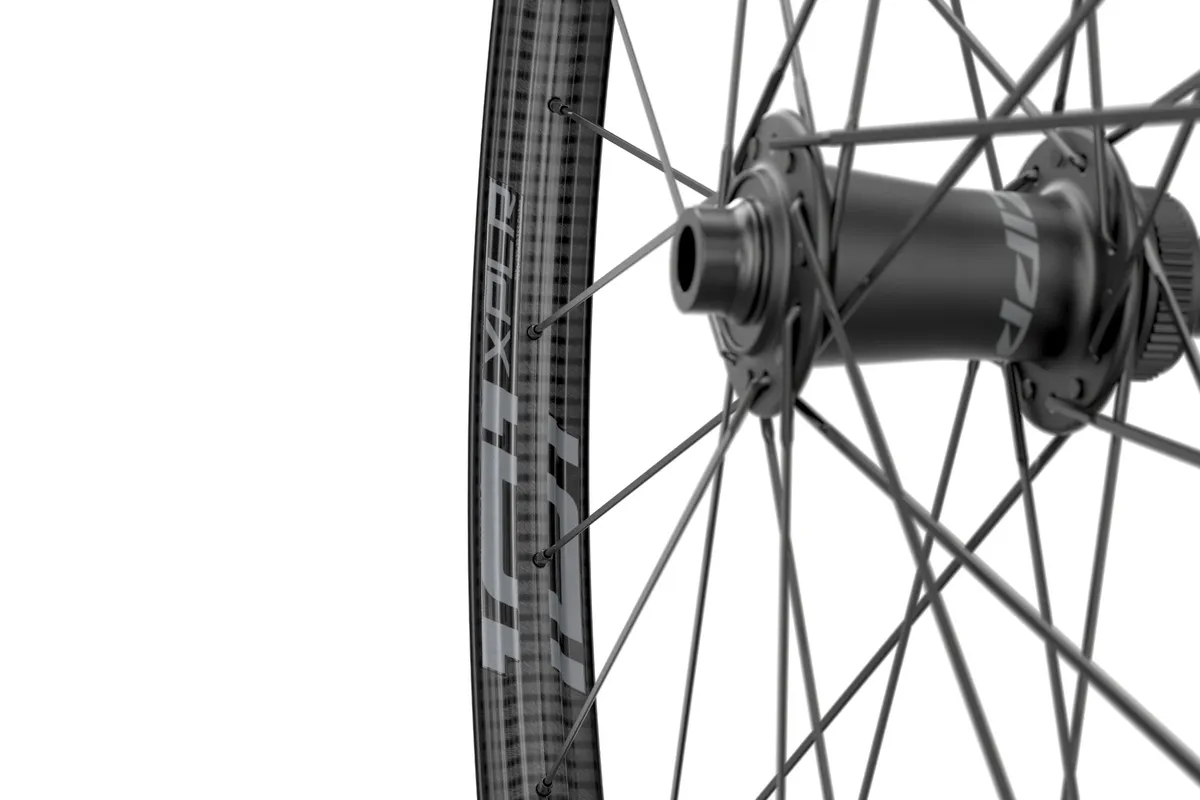
With the allowances for such big gravel bike tyres, the 101s will allow plenty of scope for experimenting with tyre size and tyre pressure.
The wheels can be used with Quarq’s clever Tyrewiz for Moto, which fits flat onto the rim surface, as opposed to the standard Quarq Tyrewiz, which fits on the valve stem. Still, it’s not cheap at £304 / €269.
The rims are built onto Zipp’s new ZR1 hub set, which impressed us on the new Zipp 303 Firecrest wheels recently launched, thanks to the fast freehub with 66-point engagement.
The new 101 wheelset weighs in at a claimed 1,665g for 700c and 1,590g for 650b. Compared to the flyweight of the new 303 Firecrest (1,352g) that doesn’t sound that impressive and plenty of gravel riders have already chosen the 303 as their go-to gravel option.
However, it’s worth noting the new 101 is actually lighter than the previous-generation 303 (1,678g a pair) and the 101’s rim technology is designed to offer increased comfort.
It’s something we’ll put to the test, but due to global production and shipping delays, it's the only element of the new XPLR range we haven’t managed to get our hands on at launch. Instead, our test rigs have come with 303 Firecrests. As soon as the new hoops land, we’ll be well placed to make a direct comparison and see if Zipp’s ‘ankle compliance’ really does live up to the claims.
Zipp 101 XPLR pricing
The Zipp 101 XPLR is priced at £780 / $850 / €870 for the front wheel and £866 / $950 / €970 for the rear, so that’s £1,646 / $1,800 / €1,840 a pair in both 700c and 650b (compared to the 303 Firecrest at £1,600 pair).
You can choose from either ‘Kwiqsand’ (sand) or standard Zipp graphics.
Coming soon
We’ve got two bikes built up with XPLR kit, one is with our mountain bike supremo Rob Weaver and the other with me (senior technical editor for road, Warren). We’ll get our heads together, looking at the full XPLR range from both road and MTB perspectives, and deliver a full review in due course.
Has this trio of US brands given us the equipment to make gravel riding better? Or have they pushed gravel tech too far into the realms of mountain biking? This one’s going to divide opinion, so let us know what you think.
